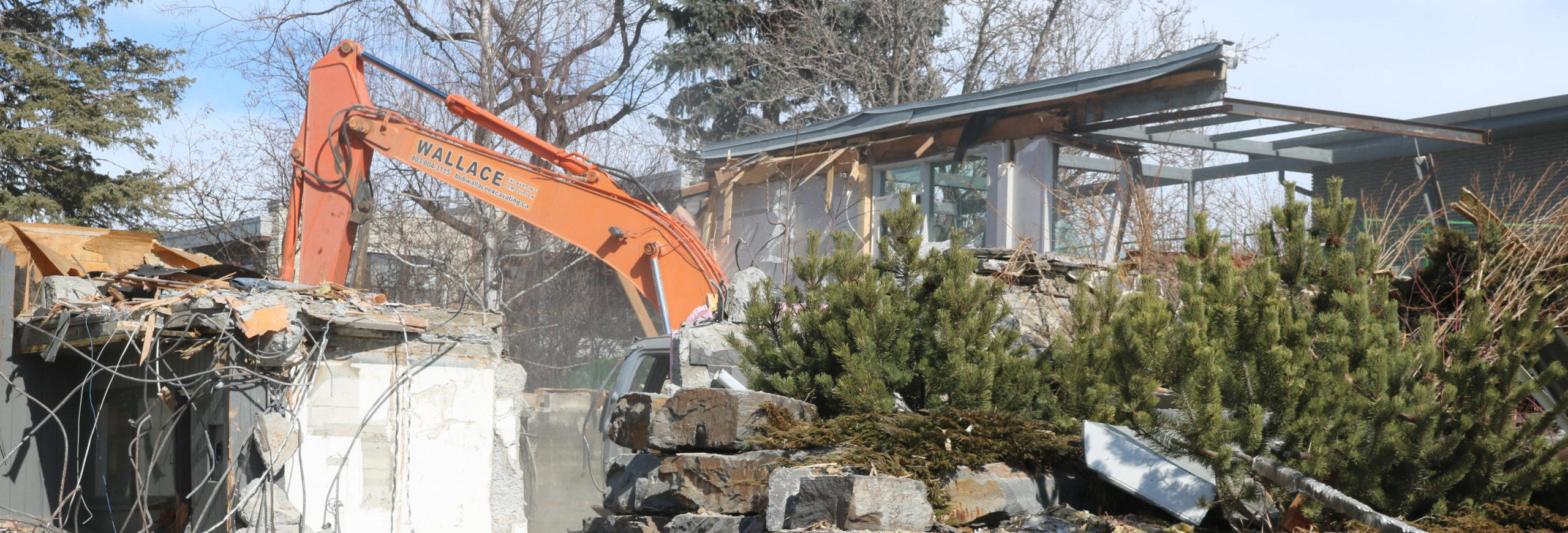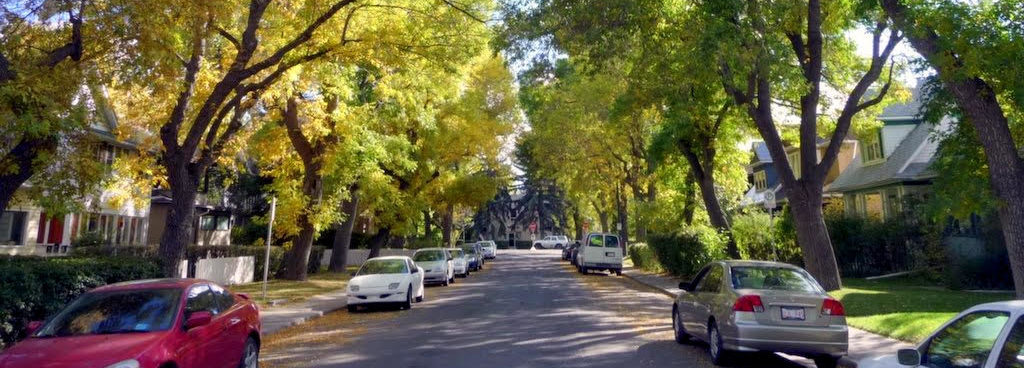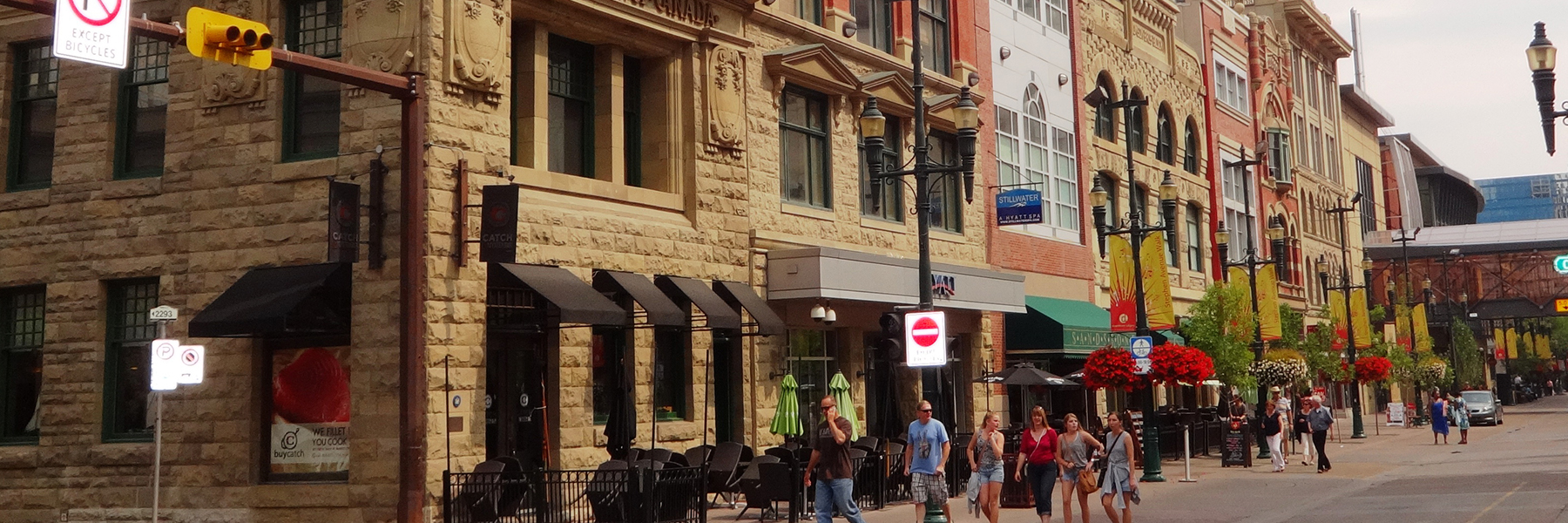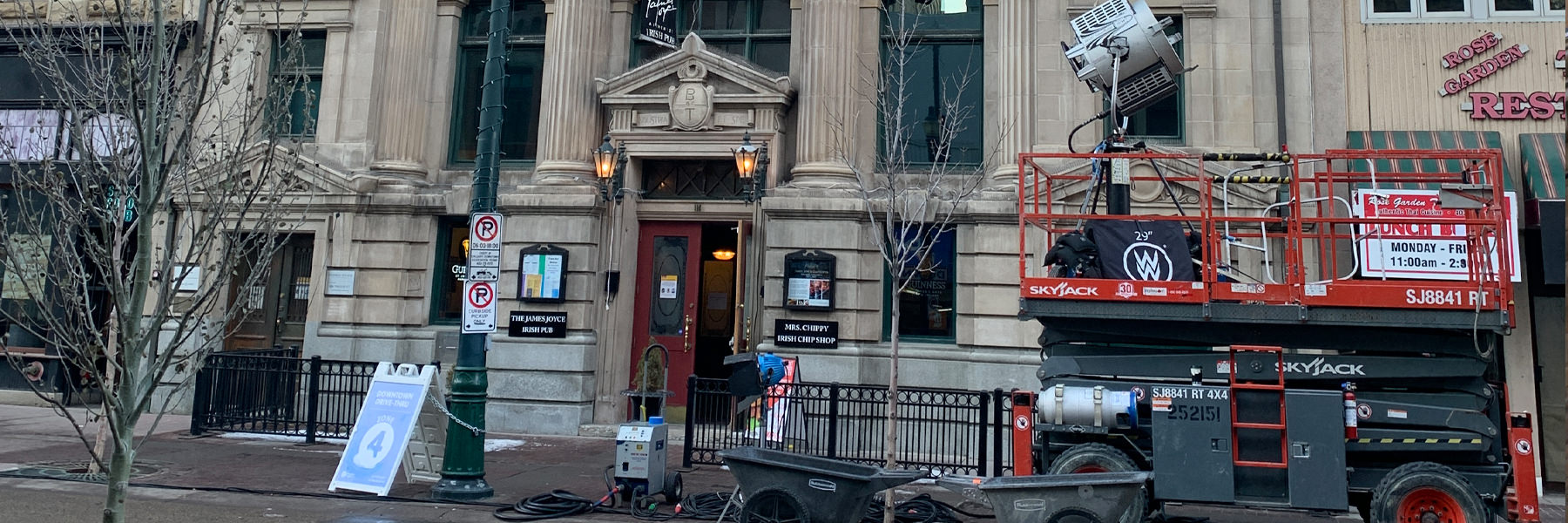Economic Benefits
Heritage preservation not only beautifies the city, it makes good economic sense for a post-COVID and oil-slump recovery. Neighborhoods with a mix of older, smaller buildings support higher levels of economic activity and social activity than areas dominated by newer, larger buildings. Walkable communities support small-scale Etsy-style retail. Studies show that neighbourhoods with a mix of smaller-scale old and new buildings host a significantly higher proportion of new businesses, as well as more women and minority-owned businesses, than areas with predominantly larger, newer buildings. Who doesn’t want to walk along a historic main street?
Historic preservation is one of the highest job-generating economic development options available. Rehabilitation has a greater impact on the local economy than the same amount of new construction. Suppose a community is choosing between spending $1 million in new construction and spending $1 million in rehabilitation: Some 5 to 9 more construction jobs will be created with rehabilitation; 4.7 more new jobs will be created elsewhere in the community with rehabilitation. Historic building preservation generates upwards of 21% more jobs, including skilled jobs, than the investment in new construction. The improvement of existing dwellings creates 40% more GDP in Canada than new construction (Marc Denhez, heritage expert). Restoration of heritage buildings also ties into investment in the green economy, for example, by adding hidden density with secondary and backyard suites. The revitalization of heritage enhances the municipal tax base without requiring significant upgrades to public infrastructure, often not the case for new construction. Encouraging the retention of trees on private land helps sustain the urban forest canopy at no cost to the City.
Prospective employers and industries benefit from attracting talent to cities with distinctive heritage areas. Attractive residential areas offer a competitive advantage when pitching head office relocations to Calgary. Heritage areas contribute to urban liveability, attracting talent and providing an enabling environment for job creation.
Innovation drives the new economy. Heritage inspires the growth of creative industries that are often tied to historic buildings and landscapes. Artisans, writers, theatres, and art galleries feel at home in low-scale historic communities. The film industry looks for “quaint neighbourhoods” that have an authentic historic feel. Filming opportunities generate revenue for municipalities and create local jobs. The cultural assets of a city – dance, theater, music, visual arts, crafts, and others – are inherently influenced and enhanced by the physical context within which they evolved. If cultural resources are to become and remain an economic asset for the city, then the physical context that has influenced their creation needs to be maintained.
Heritage areas also stimulate and support tourism. According to the World Trade Organization, tourists are shifting away from active holidays and towards experiential vacations. Modern travelers seek out destinations that offer educational opportunities, such as museums and interpretive centres, but also heritage buildings and cultural landscapes. Statistically, heritage tourists spend more money per day and stay longer (dollars spent in coffee shops, stores, and restaurants). 2.6 million Canadians identify themselves as heritage enthusiasts and 55% of this group visit Canada’s historic places. Calgary has impressive and unique historic places. Fort Calgary is a National Historic Site, and the birthplace of Calgary, where the North West Mounted Police first built a fort in 1875. Lougheed House, the Beltline's hub of cultural happenings and programs, is a National and Provincial Historic Site, museum and restaurant. Heritage tourism requires less capital, infrastructure, and skilled labour to develop. The promotion of historic districts that are aesthetically cohesive can also be important attractions. Heritage areas can result in a positive economic impact from tourism, and also serve as a differentiator to compete with other cities for talent and investment.
References:
Boon, Jacob. 2017, Oct.30. “Marc Denhez on the Future of Heritage,” The Coast.
Donovan Rypkema. 2005. Economics, Sustainability, and Historic Preservation.
National Trust Conference, Portland, Oregon.
City of Edmonton, Edmonton Historical Board (2017). Measuring the Value of
Heritage Preservation in Edmonton.
Crowther, Sharon. 2017, Feb.3. “The Business Case for Heritage Building Preservation.” The Globe and Mail.
Meeks, Stephanie et al. 2014. Older, Smaller, Better: New Findings from
Preservation Green Lab. National Trust for Historic Preservation.
National Trust for Historic Preservation, “Preservation & Economics: Creates Jobs.” Accessed Jan.14, 2020.
Prospector Executive Search & Consulting in collaboration with Naomi Grattan,
MA, Cultural Heritage Consultant. 2018. The Economics of Business in
Calgary: A Preliminary Business Case for Heritage Preservation. Prepared
for Heritage Calgary.

Environmental Sustainability
Did you know that the Canadian demolition and construction industry creates four million tonnes of landfill waste annually? That’s like putting the equivalent of 80,000 homes per year into the dumpster.
The cost of demolishing and rebuilding a comparably sized home is 20% higher than renovating an existing home to the standard of a new build. Those renovation costs include major structural and mechanical upgrades like a new roof, foundation, wiring and plumbing. Rebuilding at a lower quality would of may be cheaper – many infills are built of lower quality materials – but this degrades the heritage integrity and character of the neighbourhood.
Older warehouses, offices and commercial buildings offer opportunities for conversion to residential where it is most desired; close to the city center. Similarly, heritage homes may accommodate secondary suites and laneway houses. This "hidden density" means less urban sprawl, less commuting, and more effective use of existing infrastructure.
Buildings generate nearly 30 percent of all greenhouse gases. Studies have shown that it takes 10 to 80 years for the carbon savings from a new “green” building to offset the carbon impacts of its construction. By reusing existing buildings and retaining any mature trees on the site – a carbon sink remains intact and tremendous ecological disruption is avoided. New construction carries a much heavier carbon and environmental impact than preserving, adapting, and reusing heritage buildings. Reusing materials to build new buildings means that you’re saving money and resources. Some species of old-growth wood found in historic buildings are irreplaceable and can be restored and refinished multiple times. Many modern materials are made of vinyl and composite, are often shipped great distances, and are less likely to be retained in future renovations, all contributing to a higher carbon footprint.
Heritage neighbourhoods harbour valued green spaces, graceful boulevards and mature trees. Redevelopment often brings with it a larger footprint that reduces the landscaped area and mature trees. The City has an aggressive long-range target to double our urban tree canopy by 2060, but trees need space! Smaller homes on larger lots in older neighbourhoods contribute to a healthier, more sustainable city for everyone because urban trees:
- remove CO2, improve air quality and filter urban pollutants;
- provide stormwater management, flood control and slope stabilization;
- support biodiversity by providing habitat and maintaining connectivity within the ecosystem;
- reduce home heating and cooling costs;
- increase property values;
- offer beautiful places to bike and stroll.
Calgary’s early development followed our rivers and that’s where trees grow best.
It might seem obvious that leafy streets and generous footpaths contribute to our social wellbeing, but we should be reminded that they do! They too are historic resources. Heritage conservation is fundamental to sustainable development. Let heritage inspire a greener future.
“The greenest building is the one that already exists.”
– Carl Elefante
“We have to think of buildings as material depots.”
– Thomas Rau
Further Reading:
National Trust for Canada. 2020. Making Reuse the New Normal: Accelerating
the Reuse and Retrofit of Canada’s Built Environment.
Food and Agriculture organization of the United Nations. 2016. Building greener cities: nine benefits of urban trees.

Urban Livability
Calgary is ranked the most livable city in North America and the 5th most livable city in the world. What is it about Calgary that warrants this spectacular international recognition? Calgary has the most extensive outdoor pathway and urban bike network in North America. It ranks among the Top 10 global cities for family friendliness. (The results of the 2019 Global Liveability Index are administered by the Economist Intelligence Unit.) Calgary’s Municipal Development Plan (MDP) and the Calgary Transportation Plan (CTP) work towards realizing Calgary’s vision to be a sustainable, resilient city focused on maintaining world-renown quality of life, outstanding natural assets and a strong diverse economic future. A key component of livability is the quality of the built and natural environment that affects our experience of well-being.
Historic resources define places in a city to live, work and play. Distinct neighbourhoods and urban villages form an integral part of our City’s identity and connect us with the past. Engaging with historic places is associated with higher life satisfaction, increased happiness and lower anxiety. Heritage neighbourhoods rank higher in livability and community vitality. People go to historic niche commercial areas of the city to seek out a “sense of place” versus the ubiquitous “anyplace” character that newer development may convey. Commercial tree-lined streets with heritage encourage lingering and higher spending, thus supporting local businesses.
Repurposing older buildings for affordable housing, and adding suites to existing homes, provides opportunities for housing diversity and inclusiveness.
Navigating avenues of historic tree-lined streets and visiting cultural landscapes can lower feelings of stress, provide a place for relaxation, restoration and physical activity.
A lovely tree canopy encourages traffic to slow down, making for safer neighborhoods. Lower crime rates correlate with well maintained neighbourhoods and mature trees because they promote "eyes on the street," a Jane Jacobs euphemism. They expand Calgary's pathway network, provide green connections and optimize use of existing neighbourhood infrastructure, like roadways, sidewalks for the benefit of commuters, high-rise dwellers, cyclists and transit users.
The human scale and distinctive character of historic areas create a strong, appealing sense of place for residents and visitors alike. These places are critical in supporting community health and wellbeing. The unique character of our neighbourhoods reflects the diversity of our communities and the personality of our City. Historic places are the catalyst for story telling and stimulate conversations about where we’ve been, why, and how we can advance to a more inclusive and sustainable future.
Further Reading:
Twenty-Four Reasons Historic Preservation is Good for Your Community. 2020, January. PlaceEconomics.
Coyte, Matthew. The Sprawl . July 2020. Calgary Plans To Double Its Urban Forest But budget cuts threaten this goal.
Economist Intelligence Unit (EIU), ‘Global Liveability Report’
Monocle, “The Most Livable Cities Index”
Mercer, “Quality of Living Survey.”





